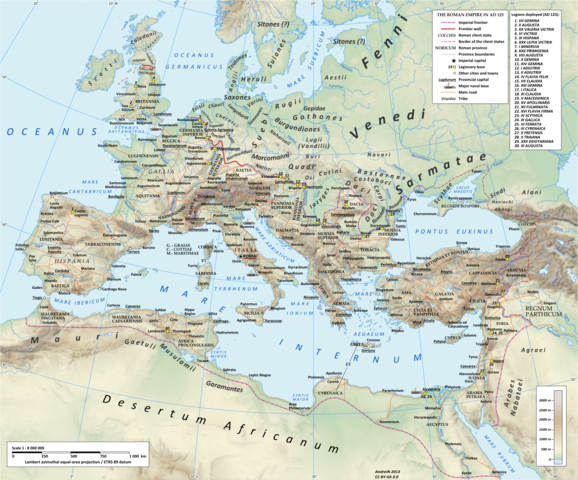ROXOLANI

The
Roman empire under Hadrian (ruled 117 – 138), showing the
location of the Roxolani Sarmatians in the Wallachian plain (Romania)
The
Roxolani were a Sarmatian people (a large Iranian confederation
that existed in classical antiquity) and are believed to be an offshoot
of the Alans. However, according to Strabo, they were the most remote
of Scythian peoples.
Name
:
In his Getica (c. 551 CE), Jordanes uses a variant name, Rosomoni
(or Rosomones) for the Roxolani. The following tribal names in Bavarian
Geographer apparently belong here [where?] :
Sebbirozi
habent ciuitates XC.
Attorozi habent ciuitates XLVIII, populus ferocissimus.
Vuillerozi habent ciuitates LXXX.
Zabrozi habent ciuitates CCXII.
Chozirozi habent ciuitates CCL.
The
etymology of Roxolani may combine ruxh or rukhs Alanic "radiant
light" + Alani. This would make Roxolani an endonym translatable
as "bright Alans". George Vernadsky suggested, along similar
lines, that the Rocas (or Rogas), a tribe conquered by the Ostrogoths
in the 4th century, may have been synonymous with the Roxolani/Rosomoni.
To be specific, Vernadsky suggested that Rocas may have its origins
in ruxh and the name of the Asii, a steppe tribe whose name may
have been interchangeable with that of the Alans.
Other
theories suggest that Iranian-speaking steppe peoples, such as the
Alans, merged in a variety of forms with early Slavic peoples. According
to one hypothesis, the Antes originated as a sub-group of Alans.
A similar theory, reported by Vernadsky, suggests that Roxolani
originated as a portmanteau of the names of the Slavic regions (Rus'
Khaganate, Kievan Rus'', 'Rus' people) and the Alani.
Geography
:
Their first recorded homeland lay between the Volga, Don and Dnieper
rivers; they migrated in the 1st century AD toward the Danube, to
what is now the Baragan steppes in Romania.
History
:
1st century BC :
Around 100 BC, they invaded the Crimea under their king Tasius in
support of the Scythian warlord Palacus but were defeated by Diophantus,
general of Mithradates VI.
1st
century AD :
In the mid-1st century AD, the Roxolani began incursions across
the Danube into Roman territory. One such raid in AD 68/69 was intercepted
by the Legio III Gallica with Roman auxiliaries, who destroyed a
raiding force of 9,000 Roxolanian cavalry encumbered by baggage.
Tacitus (Hist. Bk1.79) describes the weight of the armour worn by
the "princes and most distinguished persons" made "it
difficult for such as have been overthrown by the charge of the
enemy to regain their feet". The long two-handed kontos lance,
the primary melee weapon of the Sarmatians, was unusable in these
conditions. The Roxolani avenged themselves in AD 92, when they
joined the Dacians in destroying the Roman Legio XXI Rapax.
2nd
century :
During Trajan's Dacian Wars, the Roxolani at first sided with the
Dacians, providing them with most of their cavalry strength, but
they were defeated in the first campaign of AD 101–102 at
Nicopolis ad Istrum. They appear to have stood aside as neutrals
during Trajan's final campaign of AD 105–106, which ended
in the complete destruction of the Dacian state. The creation of
the Roman province of Dacia brought Roman power to the very doorstep
of Roxolani territory. The Emperor Hadrian reinforced a series of
pre-existing fortifications and built numerous forts along the Danube
to contain the Roxolani threat. Later, Marcus Aurelius also campaigned
against the Roxolani along the Danubian frontier.
3rd
century :
They are known to have attacked the Roman Province of Pannonia in
260; shortly afterwards contingents of Roxolani troops entered Roman
military service.
4th
century :
Like other Sarmatian peoples, the Roxolani were conquered by the
Huns in the mid-4th century.
Culture
:
The Greco-Roman historian Strabo (late 1st century BC-early 1st
century AD) described them as "wagon-dwellers" (i.e. nomads).
Source
:
https://en.wikipedia.org/
wiki/Roxolani

